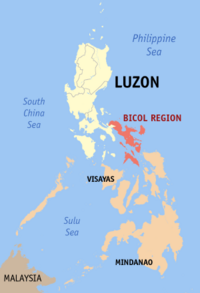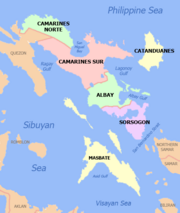Bicol Region
 |
|
| Regional center | Legazpi City, Albay |
|---|---|
| Population | 5,109,798 (2007) |
| – Density | 265.1 per km² |
| Area | 17,632.5 km² |
| Divisions | |
| – Provinces | 6 |
| – Cities | 7 |
| – Municipalities | 107 |
| – Barangays | 3,471 |
| – Cong. districts | 14 |
| Languages | Bikol, Albayano, Masbateño, Rinconada, Pandan Bikol, Sorsoganon, Tagalog |
The Bicol Region or Bicolandia is one of the 17 regions of the Philippines. It occupies the Bicol Peninsula at the southeastern end of Luzon island and some other islands.
It consists of six provinces, namely, Albay, Camarines Norte, Camarines Sur, Catanduanes, Masbate, and Sorsogon. It has one independent component city, Naga City, and six component cities, Iriga, Legazpi, Ligao, Masbate, Sorsogon, and Tabaco. The regional centers are Legazpi City, the region's political and administrative center, Naga City, the region's cultural and religious center. Legazpi City, Naga City, Iriga City and Sorsogon City are the leading cities in the region in terms of urbanization and also the hub of the region's economic activity.
Contents |
Culture
The Bicol region is often seen as the epicenter of the counterculture and liberal politics in the Philippines because many of its inhabitants seem to oppose many right-wing governments and ideology which they blame for corruption. The region has a political reputation for always voting for left-wing politicians. It is also widely seen as a stronghold for the National Democratic Front.
Language
Inhabitants, called Bicolanos, speak any one of the several varieties of Bikol, an Austronesian language closely related to other Central Philippine languages such as Cebuano and Tagalog. Bikol varieties include Bikol Rinconada (Iriga-Buhi area), the western Albay dialects (Oas, Daraga), Bikol Sorsogon (Sorsogon), Bikol Catanduanes and Bikol Partido (municipalities surrounding Lagonoy Gulf). Standard Bikol is based on the dialect of Naga City and is spoken in a wide area stretching from Camarines Norte, most of Camarines Sur, the entire east coast of Albay (including Legazpi and Tabaco) and northern Sorsogon. Standard Bikol is generally understood by other Bikol speakers and is the regional lingua franca.
The Bikol languages are the dominant languages of the region. The Filipino language (Tagalog) is also spoken in northern parts of Camarines Norte as well as in the municipality of Del Gallego, Camarines Sur. Two Visayan languages, Sorsoganon and Masbateño, are spoken in Masbate and Sorsogon; they are collectively referred to as Bisakol.
Religion
Bicol is the most secular out of the entire Philippines, as only 55% of Bicol Region inhabitants attend church weekly, compared to 68% as the nation's whole.
History
Albay's archaeology shows concrete evidence of trade with China, Malaya and Indonesia going back two thousand years. The first Spanish contact was in 1565, when a treasure-galleon returning to Cebu from Acapulco, Mexico, was swept off course and the captain recorded his awe at the sight of Mt. Mayon erupting. Mount Mayon is the most prominent of the several volcanoes in the province, and one of the most famous jewels of the Pacific Ring of Fire; its eruptions have repeatedly inflicted disaster on the province, and enriched the survivors. When at peace, it is a particularly beautiful mountain. Albay has a large amount of rich flat land, and agriculture is the largest component of the provincial economy. Coconuts, rice, abaca, and maize are the chief crops. Handicrafts bolster rural incomes. Commercial fishing is also important, and the province has several thousand manufacturing enterprises. There are plenty of places to visit, offering opportunities to swim at beautiful beaches, scuba-dive to wrecked galleons, explore caves, climb volcanoes, admire waterfalls, lush vegetation, Baroque architecture, etc.
Gold-mining and jewelry manufacture continue to distinguish the province. Agriculture and fishing are major factors in the province's economy, and several handicrafts and small-scale industries are widely practiced. The region has recently seen a revival in its tourism industry, due mainly to the popularity of the new CamSur Water Sports Complex, the Mayon Volcano and the whale shark spotting and an increase in the number of upscale resorts in the region. Daet has long been a destination for surfers. It is hoped that the planned Southern Luzon International Airport will further boost tourism in the region.
In 1942, the Japanese Imperial forces entered in Bicol.
In 1945, beginning the liberation of Bicol on April 3 to April 4, 1945 we fought the battles by joint Filipino and American soldiers together with the local Bicolano guerillas against the Japanese forces during the Bicol campaign at the end in World War II.
Administrative divisions
Bicol is composed of six provinces and 7 cities.

| Province | Capital | Population (2007) |
Area (km²) |
Pop. density (per km²) |
|---|---|---|---|---|
| Albay | Legazpi City | 1,190,823 | 2,552.6 | 466.5 |
| Camarines Norte | Daet | 513,785 | 2,112.5 | 243.2 |
| Camarines Sur | Pili | 1,533,305 | 5,182.32 | 295.9 |
| Catanduanes | Virac | 232,757 | 1,511.5 | 154 |
| Masbate | Masbate City | 768,939 | 4,047.7 | 190 |
| Sorsogon | Sorsogon City | 709,673 | 2,141.4 | 331.4 |
| Naga City | — | 160,516 | 84.48 | 1,900 |
Since Naga City is an independent component city, figures are excluded from Camarines Sur province.
Component Cities
- Legazpi City, Albay
- Ligao City, Albay
- Tabaco City, Albay
- Iriga City, Camarines Sur
- Masbate City, Masbate
- Sorsogon City, Sorsogon
Independent Component City
- Naga City, Camarines Sur
|
|||||||||||